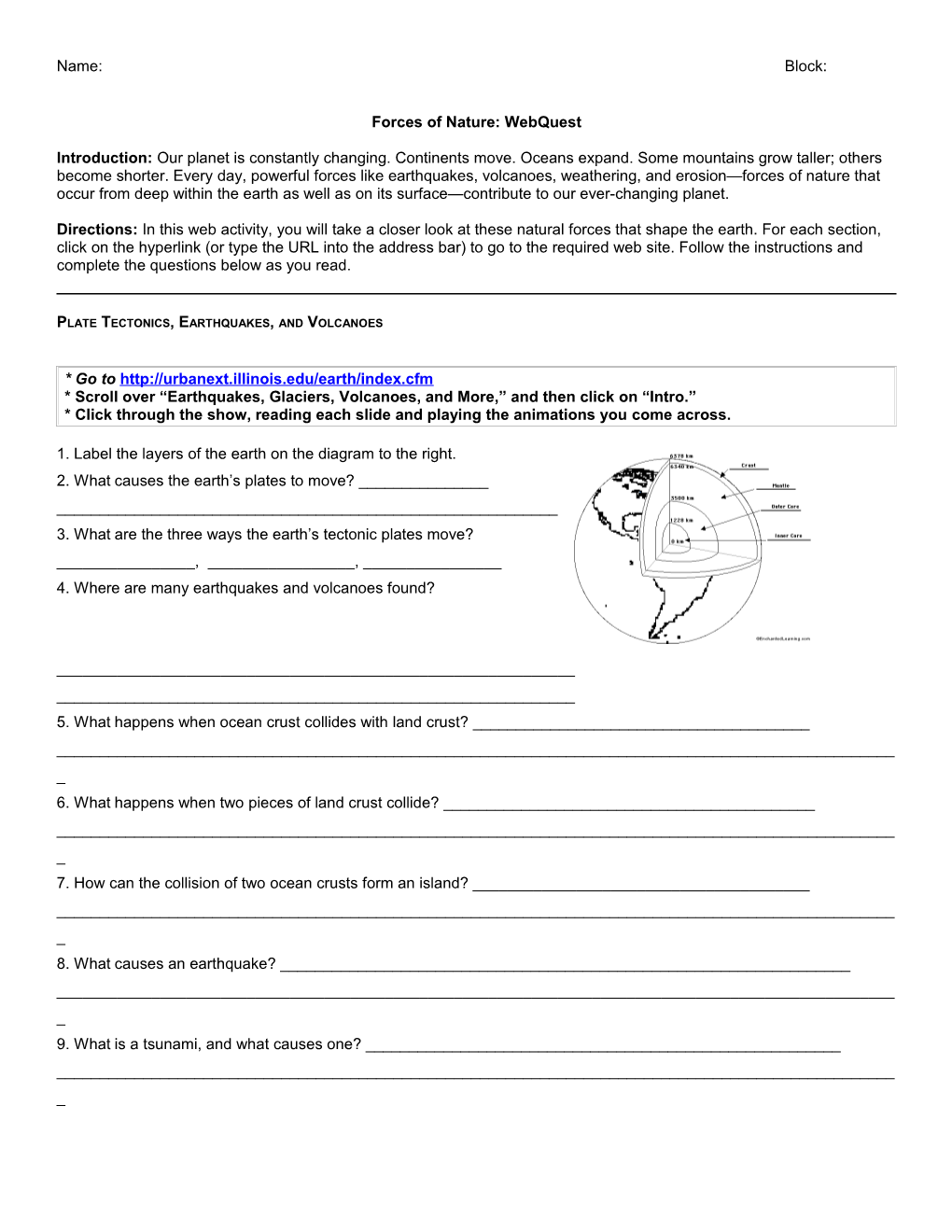Name:Block:
Forces of Nature: WebQuest
Introduction: Our planet is constantly changing. Continents move. Oceans expand. Some mountains grow taller; others become shorter. Every day, powerful forces like earthquakes, volcanoes, weathering, and erosion—forces of nature that occur from deep within the earth as well as on its surface—contribute to our ever-changing planet.
Directions: In this web activity, you will take a closer look at these natural forces that shape the earth. For each section, click on the hyperlink (or type the URL into the address bar) to go to the required web site. Follow the instructions and complete the questions below as you read.
Plate Tectonics, Earthquakes, and Volcanoes
* Go to
* Scroll over “Earthquakes, Glaciers, Volcanoes, and More,” and then click on “Intro.”
* Click through the show, reading each slide and playing the animations you come across.
1. Label the layers of the earth on the diagram to the right.
2. What causes the earth’s plates to move? ______
______
3. What are the three ways the earth’s tectonic plates move?
______, ______, ______
4. Where are many earthquakes and volcanoes found? ______
______
5. What happens when ocean crust collides with land crust? ______
______
6. What happens when two pieces of land crust collide? ______
______
7. How can the collision of two ocean crusts form an island? ______
______
8. What causes an earthquake? ______
______
9. What is a tsunami, and what causes one? ______
______
STOP when you get to the section called “Blow Your Top.”
* Go to
* At the top, where it says “Choose a Force,” click on the picture of a volcano, then read and click through the first 3 sections.
10. How many volcanoes are active around the world today? ______
11. What percentage are found in the “Ring of Fire”? ______
12. What are some benefits of volcanoes? ______
______
* Now click on the picture of the earthquake where it says “Choose a Force.” Read and click through sections 1, 2, 3, and 5.
13. How many earthquakes happen worldwide each year? ______
14. What is a seismograph, and how does it work? ______
______
Weathering and Erosion
* Go to Weathering and Erosion Video at
* Click the “play” arrow to watch the video; pause as needed to take notes
15. Physical weathering is caused by ______
______
______
16. Chemical weathering is caused by______
______
17. Erosion can be caused by ______
______
______
18. How do weathering and erosion work together to change the earth?
______
Name:Block:
Forces of Nature Acrostic Poem
Directions: An acrostic is a poem in which one word or phrase is written vertically down the side of a paper, and then each line of the poem must start with the letters of that word. Your assignment is to choose one of the forces of nature (earthquakes, volcanoes, weathering, or erosion) and create an acrostic poem that achieves each of the following:
Name:Block:
- defines the force/ tells what it is
- describes how it affects the environment
- describes how it affects humans
- includes a simile (compares one thing to another using the words “like” or “as”)
Use the web below to brainstorm some ideas, then draft your poem on a piece of loose leaf paper.
SAMPLE
Tunnel of twisting, turning, powerful winds
Over flat, open lands it
Races, demolishing homes, ripping out trees
Nothing in the path of
A tornado is safe.
Dangerous and deadly, striking as fast as a viper;
Overwhelming to behold
Name:Block:
